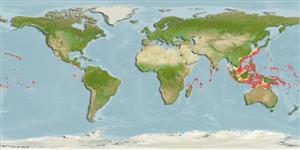Classification / Names
Common names from other countries
Main reference
Size / Weight / Age
Max length : 25.0 cm TL male/unsexed; (Ref. 2334)
Environment
Marine; reef-associated; depth range 12 - 350 m (Ref. 58488), usually 30 - 235 m (Ref. 9710)
Climate / Range
Tropical, preferred ?; 32°N - 15°S
Distribution
Indo-Pacific: scattered records from Natal, South Africa to Samoa and Hawaiian Islands and Tuamotu Islands, north to southern Japan and the Ogasawara Islands, south to Queensland, Australia.
Countries | FAO areas | Ecosystems | Occurrences | Introductions
Short description
Dorsal
spines
(total): 11;
Dorsal
soft rays
(total): 13-16;
Anal
spines: 4;
Anal
soft rays: 11 - 13. Body is light red; edges of scales slightly darker red; black of opercular membrane extending well below opercular spine; median and pelvic fins a mixture of yellow and red, usually with more yellow. Front of lower jaw fitting into a deep notch in upper jaw when mouth is closed; inner pectoral fin axil naked (Ref. 4538). The only Micronesian soldierfish with bright yellow fins (Ref. 37816).
IUCN Red List Status (Ref. 115185)
Threat to humans
Harmless
Human uses
More information
ReferencesAquacultureAquaculture profileStrainsGeneticsAllele frequenciesHeritabilityDiseasesProcessingMass conversion
Tools
Special reports
Download XML
Internet sources
Estimates of some properties based on models
Phylogenetic diversity index
PD50 = 0.5000 many relatives (e.g. carps) 0.5 - 2.0 few relatives (e.g. lungfishes)
Trophic Level
4.0 ±0.67 se; Based on food items.
Resilience
High, minimum population doubling time less than 15 months (Preliminary K or Fecundity.)
Vulnerability
Low vulnerability (19 of 100)
Price category
